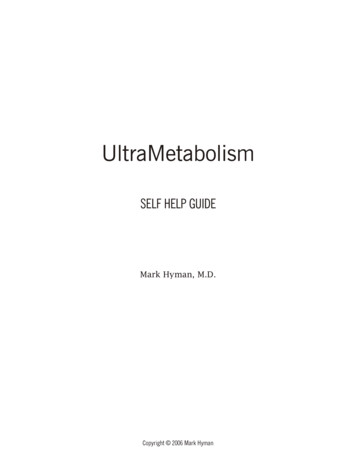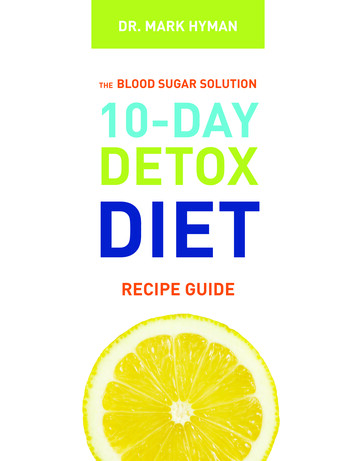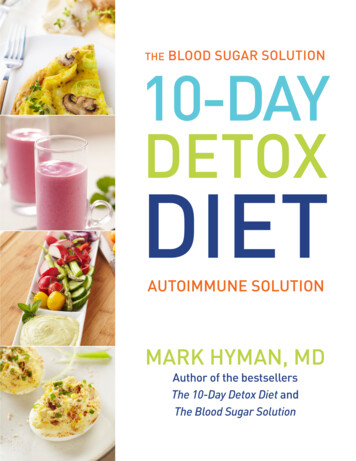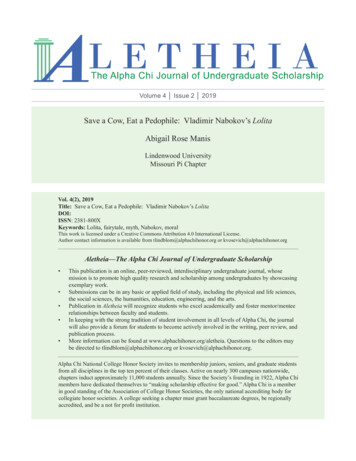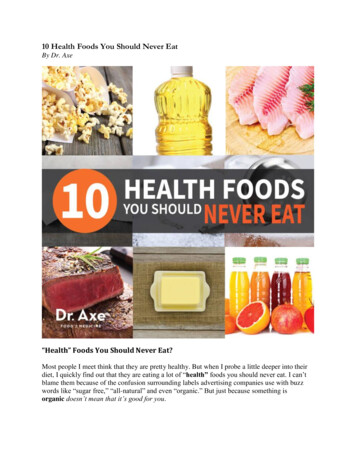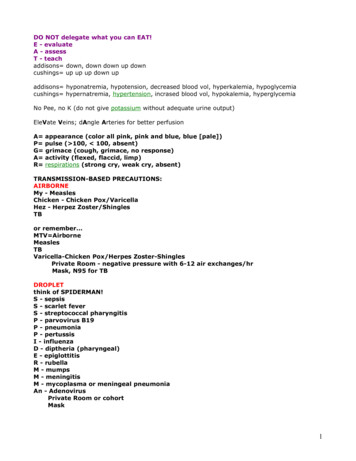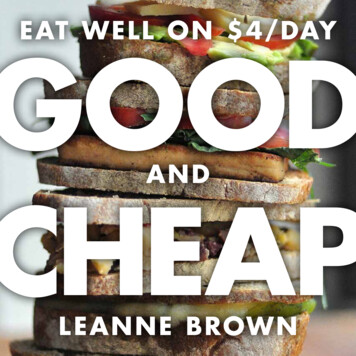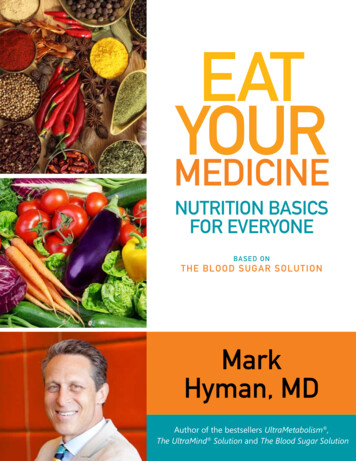
Transcription
EATYOURMEDICINENutrition basicsfor everyoneBA SED ONT H E BL O O D SU G A R SO L U T I O NMarkHyman, MDAuthor of the bestsellers UltraMetabolism ,The UltraMind Solution and The Blood Sugar Solution
Table of ContentsQuit the 5 Foods That Cause Diabesity . 35 Steps to Get Started on The 6 Week Blood Sugar Solution . 46 Week Road To Success: Inflammatory Ingredients To Avoid . 5All Calories are NOT created equal. Focus on food quality . 64 Principles for a Healthy Planet and a Healthy You. 6Choose SLOW Carbs, not LOW Carbs . 6Fat Does NOT Make You Fat . 7Eat High - Quality Protein for Blood Sugar and Insulin Balance and Hunger Control . 8Use Herbs and Spices to Add Flavor and Make Your Meals Come Alive . 8Nutrition is Not Solely About What to Eat But Learning How and When. 8Avoid Food Allergies and Sensitivities . 9Eat Well For Less: Reorganizing How You Spend Your Money Can Also Change Your Health . 9How to Succeed at Restaurants, Business Luncheons, Social Events . 9Create An Emergency Pack . 10Be Prepared For Holidays and Special Events . 10Proper Metabolism Begins With the Breath . 11Putting It All Together: Record Your Meal-Time Experience In a Journal . 11Appendix A: Serving Sizes . 12Appendix B: Phytonutrient Rich Foods . 14Appendix C: Low Glycemic Vegetables . 15Appendix D: Sea Vegetables . 16Page 2
Quit the 5 Foods That Cause DiabesityThe following foods spike insulin, which is the fat storage hormone responsible for you belly fat.These foods also cause cravings and can be addictive. They mess up your hormones and brainchemistry, increasing you appetite and causing you to crave sugar and refined carbs. The key toregaining control of your hormones and brain chemistry is to cut out these foods and eat realfood.1. Sugar - Avoid all pseudonyms for sugar including artificial sweeteners and even socalled healthy alternatives such as stevia and agave. Ditch the sweetened and sugarydrinks too. No juice, alcohol, sweet coffees or other liquids full of sugar. If you have toask, “is this okay for me?” it isn’t! After even only one to three days off sugar, yourbrain chemistry will change, ending the vicious cycle of addiction and cravings. Sugar iseight times more addictive than cocaine!2. All flour products (even gluten free) - From bagels, crackers and pasta to cookies,wraps and pizza dough, we are bombarded with poor quality sources of carbohydrates atevery meal. Avoid these foods. They are absorbed into your bloodstream too quickly,causing blood sugar to rise and insulin to spike. Remember that gluten free alternativesmight even cause as big a spike (or bigger!) in blood sugar than the wheat-based product.3. Processed junk “food” - This includes all trans fats, (avoid anything with hydrogenatedoils) and poor quality fats, high fructose corn syrup, artificial sweeteners and flavorings,preservatives, dyes and anything you could not imagine growing in nature. All of thisstuff literally confuses the body. Your weight regulation and metabolism malfunctions.MSG (monosodium glutamate), for example, found in most processed foods often underother names such as hydrolyzed vegetable protein, yeast extract or gelatin–dramaticallyincreases cravings and binge eating.4. All gluten and dairy - These are the two most common major inflammatory foods in ourmodern diet. Foods that trigger inflammation tend to promote obesity and diabetes. Thescary part is that most people are unaware of their hidden sensitivity to gluten and dairy.Besides a scale that just won’t budge, other signs of a food sensitivity are: nasalcongestion, indigestion, bloating, autoimmune diseases, rashes, drops mood or energy,headaches, joint or muscle aches, and even chronic disease such as heart disease andcancer.Curious to learn whether you have a food sensitivity? Try eliminating gluten and dairy tosee if those stubborn pounds start falling off your waist!5. Higher Glycemic Index Carbohydrates - This includes all grains, starchy vegetablesand fruit. You should do this only if you have advanced diabesity, have type 2 diabetesor are hitting a stubborn plateau with weight loss.Page 3
Interested in getting results faster or moving past a weight plateau?Here’s a great way to get a jumpstart on losing those stubborn pounds and healing fromdiabesity. For six weeks, avoid carbohydrates with a higher glycemic index such as potatoes,grains and fruit (besides a small serving of berries daily) to give yourself a metabolic tune up.While these vegetables and fruits can be healthy and full of nutrition, they may cause a spike inblood sugar and an insulin surge too great for certain individuals.5 Steps to Get Started on The 6 Week Blood Sugar Solution1. Get Prepared: Connect with your motivation for getting healthy by keeping a journal. Write aboutwhy you want to change and what is important to you. Dancing at your son’swedding, playing with your grandchildren, feeling more energy?Take measure of yourself (record your weight, height, body mass index, fasting bloodsugar, blood pressure and cholesterol). You may even want to do specific medicaltests to help you assess your diabesity and its root causes. In my free guide, How ToWork with Your Doctor to Get What You Need, you can find exactly what tests youshould do, what they mean and what to do about any abnormal results.Do a pantry and kitchen makeover (get rid of the 5 foods that cause obesity and addin real whole foods from the pantry list in The Blood Sugar Solution Cookbook).2. Detox from Addictions: Carefully eliminate substances that keep your body on the viscous cycle of cravingsand addictions. Sugar, alcohol and caffeine are best eliminated before you start the 6weeks. In my book, The Blood Sugar Solution, I show you how to do this without theuncomfortable side effects.3. Add in the right foods and lifestyle habits to turn on weight loss: Start filling your pantry and refrigerator with fresh, whole, real foods. Choose freshvegetables, berries, whole grains, beans, nuts, seeds and lean animal protein such asfish, chicken and eggs. No gimmicks or weird stuff – just actual food! And learn tocreate the perfect plate and eat twice as many veggies as anything else on your plate.This helps balance blood sugar and keeps you feeling full. Here’s the breakdown:o 50% low starch, low-glycemic veggies (crunchy or green ones). These are fiberrich foods to help reduce glycemic load. You actually get unlimited refills on thisside of the plate.o 25% lean and clean protein. A serving size the size of your palm.o 25% slow-burning carbs like gluten free whole grains or sweet potatoes.Page 4
Examples of meals you can eat:o Breakfast: vegetable frittata over black riceo Lunch: Triple A salad (arugula, avocado and artichokes) with canned wildsalmon and fruit – only 1 fruit a dayo Dinner: grilled chicken, broccolini, ½ cup adjuzki beans4. Get Together to Get Healthy: Find a partner in your home, your neighborhood or even online, and share the journeyof getting healthy together. Not only does finding a partner or group to do this withwork twice as well and lead to twice as much weight loss, but it is also more fungetting healthy together than alone.5. Personalize it! What makes this program unique is your ability to customize a plan to get real, lastingresults. Diabesity can be caused by or worsened by many things: inflammation,environmental toxins, gut problems, hormonal imbalances and nutritionaldeficiencies. Customizing the program according to your specific triggers will helpyou get the best results. The Blood Sugar Solution provides specific quizzes andpersonalized recommendations to fix these problems. This is the last diet you willever need because this last step tailors your individual symptoms with specificpersonalized solutions. You will, once and for all, heal your symptoms at their rootcause and feel like a new person. People say to me all the time that they never knewhow sick they were until they started feeling so well. This step shows you how!6 Week Road To Success: Inflammatory Ingredients To Avoid Sugars in all forms: from syrups, nectars and honeys to stevia, sucralose and xylitol. Ifyou have to ask “is this okay?” it isn’t.Flours in all forms: including seemingly benign gluten free. Avoid bagels, wraps, pasta,pastries, bread etc.All Processed food: As Michael Pollan says, if it was grown on a plant, not made in aplant, then you can keep it in your kitchen. If it is something your great grandmotherwouldn’t recognize as food, throw it out (like a “lunchable” or go-gurt”). Stay away from“food-like substances.”Gluten and dairy: All forms and please remember to read ingredient labels for hiddensources.Advanced Plan? Avoid ALL grains, starchy vegetables and fruit (except ½ cupberries per day)Page 5
After 6 weeks please refer to chapter 26 in The Blood Sugar Solution book to learn how tosafely reintroduce these foods without sabotaging your successAll Calories are NOT created equal. Focus on food quality Food is information and literally talks to your genes and controls gene expression,hormones and metabolism. What you eat has the potential to determine if you willdevelop disease or gain weight. Eating a sugar cookie versus a small handful of rawalmonds can promote expression for disease. So choose a nutrient dense meal wherethere are quality calories working for your health goal!Honor responsible portion sizes. See chapter 19 of The Blood Sugar Solution andAppendix A for more examples of portion sizes for when the 6 weeks are over.Glycemic Load is MORE important than mastering calories: How quickly your mealraises your blood sugar and spikes insulin is the essential piece of information you needto understand to sustain healthy weight and wellness. Foods with fiber, protein and antiinflammatory fats mitigate the negative effects that blood sugar and insulin spikes haveon your system. Curious about what this looks like? Dr. Hyman’s nutritionally balancedand complete meal plan provides a terrific example of how to create low glycemic loadmeals.Always combine a carbohydrate with some fiber, protein or anti-inflammatory fats.Never carb it alone!4 Principles for a Healthy Planet and a Healthy You Eat REAL food. Shop the perimeters of your market for nutrient-dense whole foods.Clean up your diet. Choose organic, grass-fed and pasture-fed meats and wild, small andsustainably farmed fish.Go organic. Choose as much organic food as your budget allows. See the top offendersat www.ewg.orgStay local. Farmers Markets and CSA’s are great opportunities to procure high qualityfresh food.Choose SLOW Carbs, not LOW CarbsGreen Carbs: Eat Freely Fill your plate with 50% slow-burning, low GI vegetables such as kale, broccoli, lettuce,radish, arugula, celery, mushroom, snap pea, bok choy, asparagus, bell pepper,watercress, cauliflower, Brussels sprouts, tomato, dandelion greens, hearts of palm,cucumber etc. See Appendix C for more low GI vegetable ideas.Seaweeds: For more information on seaweeds see Appendix DPage 6
Yellow Carbs: Eat in Moderation Avoid if on the Advanced Plan Whole Grains. Brown and black rice, quinoa, amaranth, millet, teff and buckwheatLegumes. Red, green and yellow lentils, black beans, kidney beans, adzuki beans, mungbeans, chick peas, pinto, black-eyed and fava beans etc.Dark Berries. Blackberries, raspberries, strawberries, wild blueberries. Limit to ½ c ofon the Advanced PlanStone Fruit. Nectarines, plums, peaches, apricots.Apples and PearsFiber. Aim for 30-50g dailyRed Carbs: Eat LIMITED Amounts Starchy, high glycemic cooked vegetables. Sweet potato, yam, winter squash, parsnip,pumpkinHigh-Sugar fruits. Grapes, bananas, dried fruit like raisins, dates, etc. and all fruit juiceor fruit packed in juiceForbidden Carbs: Avoid COMPLETELY Processed carbsGluten-containing whole grains (wheat, barley, rye, kamut, spelt, einkorn, triticale)Dried fruitResistant starchBoost Phytonutrient Intake by choosing foods with dark colors. See Appendix B for a listof phytonutrient rich foodsFat Does NOT Make You Fat Get an oil change: replace the BAD fat with the GOOD fatChoose anti-inflammatory fats such as omega 3 fats and monounsaturated fat overtrans and hydrogenated fatsOmega 3’s: wild or sustainably raised cold-water fish such as salmon, sardines, herring,small halibutMonounsaturated Fats: Olives and oil, avocadoHealthy Oil Choices: Extra Virgin Olive Oil, walnut and flax oil for salads, sesame,grapeseed and sunflower oil for bakingHealthy Saturated fat? Yes! Enjoy coconut butter and oil in place of butterPage 7
Eat High - Quality Protein for Blood Sugar and Insulin Balance andHunger Control Beans or legumesWhole soy products. Choose Non-GMO and organic, avoid industrial over processedsoyNuts and SeedsOmega-3 eggs or Free range eggsMercury-free fish, shrimp, and scallopsOrganic, grass-fed, and hormone-, antibiotic-, and pesticide free poultryResponsibly small portions of wild game and lean and clean red meat. See Chapter19 for more details.Use Herbs and Spices to Add Flavor and Make Your Meals Come Alive Wheat Free Tamari, Red Chili paste (Sriracha is great!), Tahini, Exotic spices,Kosher salt, Peppercorns, Fresh Herbs, Homemade or store bought organic, GF,low Sodium broth or stock.Canned Foods: canned salmon, sardines, boxed tomatoes, beans or frozen artichokesNutrition is Not Solely About What to Eat But Learning How and When Creating the perfect plate to ignite your metabolism:o 50% Low Starch, Low Glycemic Carbohydrate vegetables (as much as you like!)o 25% Lean and Clean Protein (fish, chicken, eggs, meat, beans, whole soy)o 25% Complex, Slow Burning Carbohydrate (whole grains, sweet potato, wintersquash)o If on the advanced plan, simply make you plate 75% low starch vegetables andprotein 25%Avoid Eating Like A Sumo Wrestler and Earn Your Ideal Body: always have aprotein-based breakfast within 1 hour of waking up, eat a protein-based mini meal every2-4 hours, and stop eating at least 3 hours before retiring to bed.Establish Your Rhythm and Stick to It: Your body evolved and exists today because ofnatural rhythms. Stick to a rhythm and a schedule of when you wake up and go to bed,when you eat and when you exercise. But especially when you eat. This will optimizedigestion, empower your metabolism and synchronize hormones.Page 8
Avoid Food Allergies and SensitivitiesSome foods for some people have the wrong information: Because food isinformation, take note on which foods signal unhealthy messages to your body. Mostcommon are gluten and dairy. Please avoid for these for 6 weeks. After week 6 revisitchapter 26 to properly reintroduce them into your diet without sabotaging success!Eat Well For Less: Reorganizing How You Spend Your Money Can AlsoChange Your Health Because cheap food is inexpensive due to subsidization it might seem like you have tobuy this junk food in order to stay within your budget. For 1 week track all yourexpenses and observe how much of what you spend your money on contributes to achievingyour health goals. If you can see certain items that do not serve your ultimate health goalsperhaps this is a good place to start rearranging your spending habits. Reorganize your budget and priorities and potentially create more funding for goodfood. Money is like life energy. It represents your time in a monetary way. How youspend your money reflects how you spend your time. What do you want thispattern to reflect for you? Make choices that give you MORE resources: Choose three things to change that cangive you more time or money and record them in your journal. Reflect on how your lifeand health change as you go through the 6 weeks. Dr. Hyman’s Tricks For Eating Well For Less:o Shop at neighborhood stores like Trader Joes or shopping clubs like Costcoo Join your local food co-opo Join Community Supported Agriculture programs (CSA’s)o Develop a repertoire of cheap, easy-to-prepare meals which decrease stress, timeand costo Create a “pot luck club” at workHow to Succeed at Restaurants, Business Luncheons, Social EventsFor 6 weeks try your best to AVOID these situations as surely it creates anxiety andprecarious eating adventures. However, when you must, follow these guidelines: Be Obnoxious! Be clear about your needs and do not accept any food that does notnourish or support you. Do not assume you are being impolite; you are simply takingcare of yourself.Choose the restaurant when you can.Tell the server you do not want bread on the table nor the alcohol menu. But do askfor raw cut-up veggies-no dip.Page 9
Ask for water. Drink 1-2 glasses before your meal to reduce appetiteTell the server you will die if you have gluten or dairy. Not a lie-just a slow death.Ask for simple food preparation. Grilled fish with an entire plate of steamedvegetables with some olive oil and lemon drizzled on top. Always ask for olive oil andlemon in lieu of dressing. These often have hidden dairy and gluten as well as unhealthyoils.Skip the starches. Ask for double vegetablesAvoid sauces, dressings and dips which are usually laden with hidden sugars, poor oils,gluten and dairyFollow “hari hachi bu.” Do as the Okinawan Japanese do and stop eating when youare 80% full. Instead of eating until you are FULL, eat until you are NO LONGERHUNGRY! Bring leftovers home as even too much of the right foods may spike insulin.Ask for berries for dessert.Create An Emergency Pack Buy a small hand-held cooler you can keep in your car, at work, trips etc. It’s yourlife pack.What’s in Dr. Hyman’s Life- Pack:o Small bag of raw almonds, walnuts or pecanso Small bag of cut carrots or celeryo Small container of hummus such as Wild Garden single-serve packetso Can of wild salmon or sardineso A container of chickpeas with olive oil, lemon, herbs, salt, peppero Healthy whole food protein bar (eat half in morning, half in afternoon)o Bottle of waterBe Prepared For Holidays and Special EventsSometimes you will have to eat someplace where you perceive to have no control. Avoidfood-anxiety by planning ahead and making your host aware of your dietary needs and: Eat a small protein-based meal before the eventBring your emergency pack as a backup in case there is nothing to eat. You can alwayseat after.Just relax and eat. Choose nourishing foods such as lean poultry, fish, beans andvegetables. Have as many vegetables as you want. Do your best and relax. Stress willdecrease your metabolic power. And remember, there is always tomorrow to resumeyour routine in the morning!Page10
Proper Metabolism Begins With the Breath Mindful Eating increases awareness, pleasure, digestion, absorption and metabolismof your meal. Notice how your food looks, feels and tastes in your mouth. How doesthe smell and thought of your meal make you feel? Savoring your meal is an act ofgratitude to your body and the earth that created your food.When we eat unconsciously we eat more. Avoid multitasking while eating and eatwhile you eat. Nothing more! Turn off the phone, TV, email, computer and take a breakfrom media while you focus on nourishing yourself.Remember the 20 minute rule. By eating consciously and slowly, you allow yourself tohonor your true hunger and satiety needs by providing ample time for your brain to getthe signal that your stomach is full.Steps to Practice Mindful Eating:o “Take Five” before a meal. In one minute transform your metabolism by takingfive slow breaths. Breathe in through your nose for a count of 5, pause, outthrough your mouth for a count of 5. Repeat 4 more times or until you feelrelaxed and ready to begin your meal. You can put one hand on your belly to helpyou connect with deeper belly-breathing.o Offer gratitude before the meal.o Bring your attention fully to the food.Putting It All Together: Record Your Meal-Time Experience In a Journal Write down what you ate in as much detail as possible.Think about how this meal or snack made you feel. How does your body feel? Do youhave more or less energy? How has your digestion been altered? How did you sleep thatnight?Every evening, think about how your experience with food impacted your day.Page11
Appendix A: Serving SizesEat 3 meals per day with 2 snacks. Each meal can have 15 grams of carbohydrate, and eachsnack, 7.5 grams. As your activity increases, you can slowly begin to double this. This is notintended to be a life-long way of eating. As insulin sensitivity improves, you can increase yourconsumption of natural carbohydrates to 30-50 grams per meal. Choose primarily from starchyvegetables, whole grains, legumes, fruit and yogurt. Reduce refined carbohydrates and sugars.STARCHY VEGETABLES (Cooked unless noted otherwise. Each selection contains 15grams of carbohydrate)Food ItemServingFood ItemServingWinter squashBeetrootCarrotsGreen peasTurnipsParsnipPumpkinSweet potato/yam½ cup1 cup1 cup½ cup½ cup2/3 cup1 cup½ mediumArtichokesBurdock Root (raw)CornJerusalem artichokesLima BeansBaked PotatoSwede1½ root½ cup½ cup½ cup½ medium¼ largeLEGUMES (amounts are cooked unless noted otherwise. Each serving contains 15 grams ofcarbohydrate)Food ItemServingFood ItemServingAdzuki beansBroad (fava) beansBlack-eyed beansKidney beansMung beansSplit peas¼ cup½ cup½ cup1/3 cup1/3 cup1/3 cupGRAINS (cooked unless noted)Food ItemServingBrown riceBuckwheat (kasha)Teff1/3 cup1/3 cup1/3 cupBlack beanChickpeasFrench beansLentilsNavy or pinto beans1/3 cup1/3 cup1/3 cup1/3 cup1/3 cupFood ItemServingMilletPolentaQuinoaPopcorn (popped)1/3 cup1/3 cup1/3 cup2 ½ cupsWhole-grain Flour and meals (items are dry, and contain 15 grams carbohydrates)Food ItemServingFood ItemServingAmaranth flourBrown rice flour2 Tbls.2 Tbls.Arrowroot flourBuckwheat flourPage122 Tbls.31/2 Tbls.
Fruit (all fruits are raw, unless noted) Selections equal 15 grams carbohydrateFood ItemServingFood ItemServingApple1 smallApplesauce w/o sugar ¾ cupDried apricots7 halvesBanana½ mediumFresh berries¾ cupCurrants, dried2 Tbls.Figs, dried1 mediumGrapes15 grapesMangos½ mediumNectarines1 mediumTangerines2 smallPears½ largePrunes3 prunesStrawberries1 ½ cupTomatoes1 mediumDried applesApricotsAvocadosDried hesPlumsRaisinsSun-dried Tomatoes3 rings2 medium½ avocado1 Tbls.1 cup2 medium½ large1 large1 cup cubes1 medium1 medium2 fruits2Tbls1/6 ounceBread and crackers (These are less wholesome carbohydrate options than the previous lists.But are convenient. Whole grains are always a better option.Food ItemServingFood ItemServingRice crackers4 crackersRice cakesPage132 cakes
Appendix B: Phytonutrient Rich FoodsMedical properties of different phytochemicals in a plant-rich dietCurcumin TurmericGlucosinolates broccoliAnthocyanidins Berries and Black RiceSaponins beans, quinoaQuercetin onion, appleGingerole gingerKaempferol strawberries, broccoliRutin parsley, lemonCatechins tea (white is highest in antioxidants, green is a great option too)Isoflavones soyAllicin garlicPhytosterols nuts, seedsBetasitosterols avocado, rice brownTocopherols vitamin EOmega 3, 6 and 9 fatty acids sea vegetables, salmon, borage oilSulfides garlic, onion, shallotsDIM broccoli familySilymarin artichokes, milk thistleSalycylic Acid peppermintLignans flax seed, sesame seed, broccoliResveratrol grape skinCinnamic Acid cinnamon, aloeCapsaicin chiliEllagic Acid walnuts, berriesProbiotic kimchi, sauerkraut, kefirPrebiotic FOS, inulinPage14
Appendix C: Low Glycemic VegetablesArugulaArtichokeCucumberMushroomsSwiss Bean sproutsEggplantOnionsTurnip greensBeet greensEndiveParsleyWatercressBell peppers (red,yellow, hivesBrussels sproutsGinger rootSnap beansCollard greensCabbageGreen beansSnow peasJalapeno peppersCauliflowerHearts of palmShallotsKaleSummer squashZucchiniSpinachLettucesSweet Potato, Beans, Lentils and Squash GI around 50. Medium burning but great inappropriate portions (1/2 sweet potato or ½ cup for beans, lentils and cooked squashDose makes the poison with regards to these starches! If enjoyed in appropriate amounts theyhave a benevolent effect on satiety and pleasure.Page15
Appendix D: Sea VegetablesSea vegetables have 10-20 times the minerals of those found in land plants. They are anexcellent source of minerals such as iodine, calcium, and iron. Some of the health claimsassociated with the consumption of sea vegetables include detoxification, alkalization of thebody, softening hardened portions in the body, decreasing dryness, removing residues ofradiation, lowering cholesterol, and improving water metabolism.AgarCulinary use: Natural jelling agent. Can be used in place of animal gelatin.Preparation: ¼ cup of agar gels one quart of liquid. Agar thickens at room temperature, unlikegelatin, which must be chilled.Storage: Store in a sealed container in a cool, dark place where it will keep indefinitely.Health Claim: Promotes digestion.ArameBenefits: Good introductory sea vegetable due to its milder flavor.Culinary use: Great in salads.Preparation: Soak in cold water.Storage: Store in a sealed container in a cool, dark place where it will keep indefinitely.Health Claim: If eaten daily, arame will promote glossy hair and clear skin.DulseBenefits: Very high in iron (14mg per ¼ cup).Culinary uses: Leaves can be soaked for five minutes and added to soups or salads. Flakes orgranulated dulse can be sprinkled onto most food for a nutritional boost.Preparation: Soak in cold water, or add flakes directly to food.Storage: Store in a sealed container in a cool, dark place where it will keep indefinitely.Health Claim: If eaten daily, arame will promote glossy hair and clear skin.Page16
HizikiBenefits: Very high in minerals (34g of minerals/100g). Richest of all sea vegetables incalcium. ¼ cup of hiziki calcium in ½ cup whole milk.Culinary uses: Great in salads.Preparation: Soak in cold water before using. Cook in apple juice and combine with othervegetables to moderate strong taste.Storage: Store in a sealed container in a cool, dark place where it will keep indefinitely.Health Claim: Normalize blood sugars. Builds bone and teeth.KombuBenefits: Rich in minerals, kombu increases nutritional value of all food with which it isprepared.Culinary uses: Contains glutamic acid, which acts as a tenderizer. Add kombu when cooking beans.Preparation: Soak in cold water before using.Storage: Store in a sealed container in a cool, dark place where it will keep indefinitely.NoriBenefits:Culinary uses: Most commonly used in making sushi. Can also be eaten directly from package bylightly toasting and crumbling onto food.Preparation: Soak in cold water before using.Storage: Store in the freezer in a zip-lock bag to preserve freshness.Health Claim: May aid in lowering cholesterol.May help treat painful or difficult urination, goiter, edema and hypertension.WakameBenefits: High in calcium and niacin.Culinary uses: Often used in soups. Can also be toasted and ground into a condiment.Preparation: A small amount expands when soaked. Soak 10-15 minutes. After soaking, removethe main rib or stem and cut leaves into small pieces.Storage: Store in a sealed container in a cool, dark place where it will keep indefinitely.Page17
Brands to look for:Maine Seaweed Co.EdenEmerald CoveAirwanReferences:Lair, Cynthia. Feeding the Whole Family. Moon Smile Press, Seattle, WA, 1997.Copyright 2013 by Hyman Enterprises LLC; Diabesity is a trademark owned by Hyman Emterprises LLCPage18
modern diet. Foods that trigger inflammation tend to promote obesity and diabetes. The scary part is that most people are unaware of their hidden sensitivity to gluten and dairy. Besides a scale that just won’t budge, other signs of a food sensitivity are: nasal congestion, indigestion, blo
